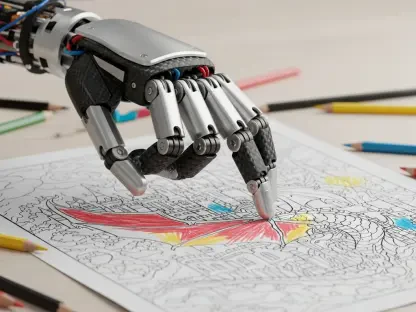Imagine a world where a solo content creator can produce a polished, cinematic video in mere hours, rivaling the output of an entire production team. This is no longer a distant dream but a reality driven by artificial intelligence in video editing. The surge in demand for video content—spurred by platforms like TikTok, Instagram, and YouTube—has created an urgent need for faster, more efficient tools. AI-powered video editing software has emerged as a game-changer, enabling creators of all skill levels to streamline workflows and unleash creativity. This review dives deep into the capabilities, performance, and implications of these cutting-edge tools, spotlighting their role in transforming the content creation landscape.
Understanding the Power of AI in Video Editing
AI video editing technology harnesses machine learning, automation, and generative models to simplify complex post-production tasks. At its core, it analyzes audio, video, and text data to perform actions like cutting clips, adding subtitles, or even generating visuals from scratch. This innovation addresses a critical pain point: the time-intensive nature of traditional editing, which often requires specialized skills and expensive software.
The rise of AI in this space aligns with a broader trend of democratizing creative tools. As content consumption skyrockets, creators face pressure to deliver high-quality videos at an unprecedented pace. AI solutions meet this demand by offering intuitive interfaces and automated features that reduce technical barriers, making professional-grade editing accessible to beginners and experts alike.
Beyond accessibility, the significance of AI extends to its integration into the larger tech ecosystem. It complements advancements in mobile computing and cloud-based platforms, allowing seamless editing on the go. This synergy empowers a diverse range of users—from hobbyists crafting social media clips to filmmakers working on intricate projects—to produce standout content with minimal resources.
Key Features of Top AI Video Editing Tools
Automation and Efficiency Boosters
One of the standout benefits of AI video editing tools lies in their ability to automate mundane tasks, saving creators countless hours. Functions like transcription, auto-captioning, and background noise removal are now handled with a single click. For instance, Descript allows users to edit videos by tweaking a text transcript, automatically syncing changes to the footage—a feature that drastically cuts down on manual trimming.
Another example is CapCut, which excels in rapid format adjustments tailored for social media. Its algorithms can reframe content for vertical, square, or widescreen outputs in seconds, catering to platforms like Instagram Reels or YouTube. Such automation frees up mental space for creators to focus on narrative and engagement rather than technical minutiae.
The impact of these productivity features cannot be overstated. Tasks that once took days, such as adding accurate subtitles across multiple languages, are now completed in minutes with tools like VEED. This efficiency is particularly valuable for small teams or solo operators who lack the budget for dedicated editing staff.
Generative and Creative Innovations
Beyond automation, AI tools are pushing the boundaries of creativity with generative capabilities. Platforms like Runway offer text-to-video features and frame-level edits, enabling users to create stunning visual effects without high-end equipment. Imagine typing a description of a surreal landscape and watching the software render it into a video sequence—such possibilities are now within reach.
These generative tools also spark inspiration by suggesting edits or effects based on content analysis. However, their power comes with a caveat: ethical usage must be prioritized. The potential for misuse, such as creating misleading content, underscores the need for guidelines and safeguards, especially in commercial applications where authenticity matters.
The creative potential of AI is reshaping how stories are told. Filmmakers on a budget can simulate expensive CGI, while marketers can craft dynamic ads from minimal input. As these features evolve, they promise to blur the line between amateur and professional output, provided users apply them responsibly.
Latest Innovations Shaping the Industry
Recent strides in AI video editing have centered on refining generative models and enhancing precision in automation. Tools now boast improved algorithms for detecting scene transitions or syncing audio with visuals, resulting in smoother, more polished edits. These advancements reflect a maturing technology that is becoming indispensable for modern creators.
A notable trend is the shift toward mobile-first solutions, catering to the growing number of creators who edit directly on smartphones. Applications like CapCut lead the charge with robust features packed into lightweight interfaces, ensuring accessibility without sacrificing functionality. Additionally, free tiers across many platforms lower the entry barrier for new users.
Creator behavior is also evolving alongside these tools. AI is no longer a novelty but a core workflow component, as seen in integrations within established software like Adobe Premiere Pro. Its Auto Reframe and Auto Color features demonstrate how even traditional editing suites are embracing AI to stay competitive in a fast-paced market.
Real-World Impact Across Diverse Niches
AI video editing tools are proving their versatility by serving a wide array of content creators. Social media influencers rely on quick-turnaround platforms like CapCut to churn out engaging TikTok videos, while podcasters use Descript to transform audio interviews into shareable clips with minimal effort. These tools adapt to varying needs with remarkable flexibility.
In professional spheres, filmmakers leverage Runway for cost-effective visual effects that rival big-budget productions. Meanwhile, marketing teams employ VEED for multilingual dubbing, enabling global reach through translated captions and voiceovers. Such applications highlight how AI caters to both short-form and long-form content demands across industries.
Workflow integration further amplifies their value. By combining multiple tools, creators can optimize output for different platforms. A brand might use VEED for initial subtitle generation, CapCut for format resizing, and Adobe Premiere Pro for final touches. This modular approach ensures efficiency and consistency, regardless of the project’s scale or complexity.
Challenges and Areas for Improvement
Despite their promise, AI video editing tools face technical hurdles that can affect quality. Inaccuracies in auto-generated captions or misaligned lip-sync in dubbed content remain common issues, often requiring manual correction. These glitches, while minor in some contexts, can undermine professionalism in polished outputs.
Ethical concerns also loom large, particularly with generative AI. The risk of copyright infringement or the creation of deceptive deepfakes necessitates strict oversight. Without clear policies, the technology could be exploited, damaging trust in digital content. Human intervention remains essential to ensure compliance with legal and moral standards.
Efforts to mitigate these challenges are underway. Platforms like Runway are implementing provenance tracking and moderation features to promote responsible use. While progress is evident, continuous refinement is needed to balance innovation with accountability, ensuring that AI remains a tool for good in the creative space.
Future Horizons for AI Video Editing
Looking ahead, the trajectory of AI in video editing points to greater accuracy and personalization. Future iterations may offer hyper-tailored suggestions based on a creator’s style or audience preferences, further streamlining the editing process. Breakthroughs in natural language processing could also enhance voice-driven editing commands.
Long-term, the democratization of content creation is set to intensify. As AI tools integrate deeper into mainstream production pipelines, they could redefine industry standards, making high-quality video accessible to even the smallest creators. This shift promises to diversify voices in media, provided equitable access is maintained.
Preparation for these advancements involves staying informed about emerging features and ethical frameworks. Creators are encouraged to experiment with evolving tools and advocate for transparency in AI development. By engaging proactively, the community can shape a future where technology amplifies creativity without compromising integrity.
Final Reflections on AI Video Editing Tools
Looking back on this exploration, the transformative power of AI video editing tools stands out as a catalyst for efficiency and innovation in content creation. Their ability to automate repetitive tasks and inspire creative breakthroughs marks a significant leap forward for creators across various domains. The nuanced strengths of platforms like Descript, Runway, CapCut, VEED, and Adobe Premiere Pro underscore their specialized roles in addressing diverse needs.
As a next step, creators are advised to test free versions of these tools to identify the best fit for their workflows. Combining multiple platforms for a hybrid approach proves effective in tackling complex projects. Staying updated on generative AI policies and maintaining a balance between automation and human oversight emerges as critical considerations for sustainable success in this evolving landscape.









